If your team is holding synchronous weekly status update meetings, you’ve likely experienced one (if not all) of the problems below.
- They are hard to schedule: With people working remotely and out of different time zones, it’s difficult to get everyone on the same call at the same time.
- They are disruptive: Team members could be in the zone and in the middle of an important task, but then have to stop what they’re doing and attend a status update. This not only hurts productivity but can also affect morale if your team feels like they’re wasting time while tasks pile up.
- They are time-consuming: The meetings can get lengthy, especially if team members start rambling and don’t deliver concise updates.
Teams can solve these problems — and more — by switching to asynchronous weekly status updates.
But asynchronous meetings can still be ineffective if you’re not using a good format.
In this post, we look at how teams can use Geekbot, our asynchronous meeting software, to run quicker and less disruptive asynchronous weekly status meetings.
Note: Geekbot is free for teams of 10 or fewer. Plus, larger teams can try Geekbot free for 30 days. Click here to learn more and sign up.
In this post, we discuss:
- The Problem with Running Passive Weekly Status Updates
- The Benefits of Using Geekbot to Run Asynchronous Weekly Status Updates (available for both Slack and Microsoft Teams)
The Problem with Running Passive Weekly Status Updates
As calendars fill up, team members could get very busy and simply forget to submit their report. And with a passive platform like Google Sheets or Google Docs, your team doesn’t have any automated reminder to help keep them on track.
The result is that someone on your team has to follow up with team members to complete their updates, otherwise they may never get done.
But while this is an inefficient process, the answer isn’t to ditch the weekly status report; the answer is to improve the format.
Below we discuss the benefits of automating your weekly status report process with Geekbot, our asynchronous meeting software.
The Benefits of Automating Your Weekly Status Reports with Geekbot
Geekbot is an asynchronous meeting software that conveniently integrates with both Slack and Microsoft Teams.
You can schedule your weekly status reports in Geekbot and then our tool will automatically send notifications to your team through either Slack or MS Teams when it’s time to fill out their updates.
And, as we discuss in more detail later in this section, if they forget to complete their updates, Geekbot will circle back via notification and remind them to fill out their weekly status report.
Now, let’s take an in-depth look at how your team can use Geekbot to run asynchronous weekly status updates.
Note: Geekbot is free for teams of 10 or fewer. Plus, larger teams can try Geekbot free for 30 days. Click here to get started.
Scheduling Your Status Report
With Geekbot, you can schedule out your status report at several different intervals. Some teams do status reports daily, weekly, or at a longer interval such as every two weeks or at the end of the month.
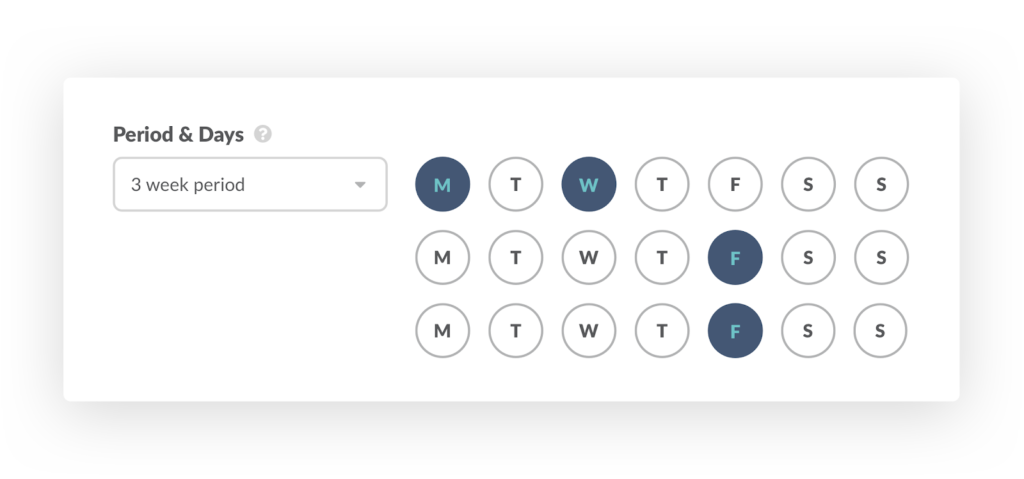
Bonus for Distributed Teams: Automatically Factor in Your User’s Time Zones
When scheduling the time that status update questions get sent out, you can tell Geekbot to factor in the user’s time zone.

This makes it easier for the administrator who’s scheduling the report because they don’t have to manually change the time based on everyone’s time zone. It also makes it easier for employees who now get notified to fill out their weekly status report when it makes sense, not at odd hours of the day (or night).
Customizing the Status Update Questions
We built Geekbot specifically to help us run our daily standups more efficiently. That’s why when you’re scheduling a weekly status report template with Geekbot, the questions default to the daily standup questions.
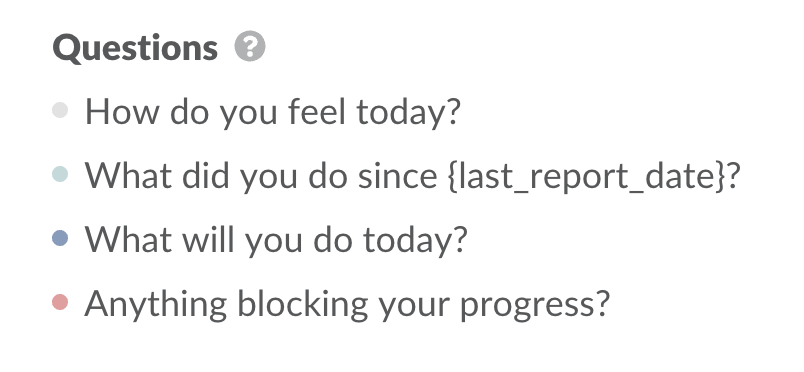
These questions are completely customizable. You can delete them, keep them, add new ones, or slightly modify our default questions.
For an example of how you can modify the questions (and the frequency of your weekly reports) check out the case study we did with one of our customers, GitHub.
Collecting Your Team’s Responses
After you’ve scheduled your report and finalized your questions, Geekbot takes over. At the scheduled time, Geekbot individually alerts each team member that it’s time to complete their weekly status update.
And, to mark a vast improvement over passive tools, Geekbot will follow up with a participant and remind them to fill out their weekly status report.
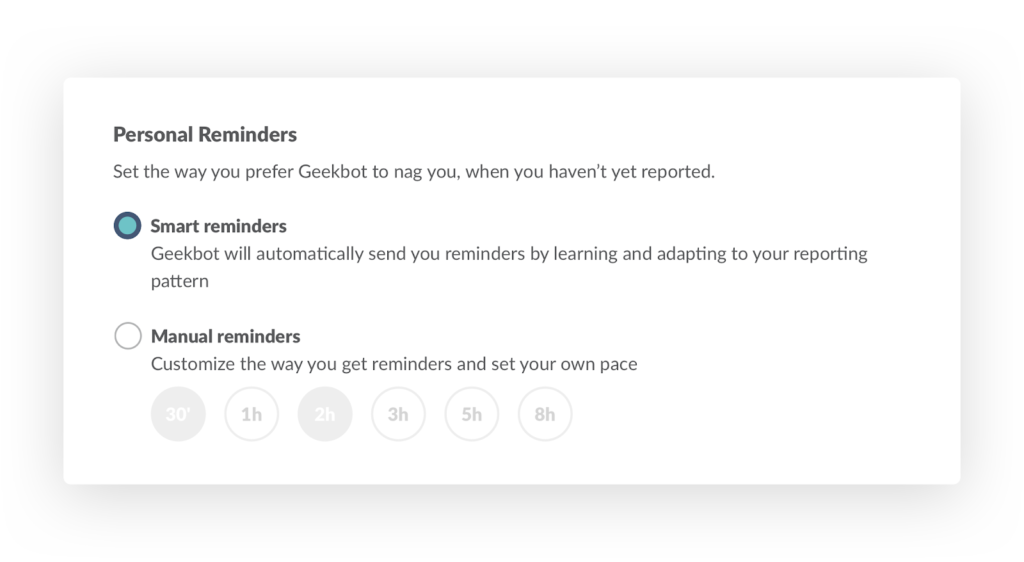
As seen above, you can either set it up so Geekbot follows up with a team member after a set time (such as in 30 minutes or in 2 hours) or you can let Geekbot learn and adapt to your team’s reporting patterns.
Once the responses are filled out, they can either be shared in a public Slack channel, a private Slack channel, or in the MS Teams channel.
Here’s what it looks like when all the responses get posted in a Slack channel.
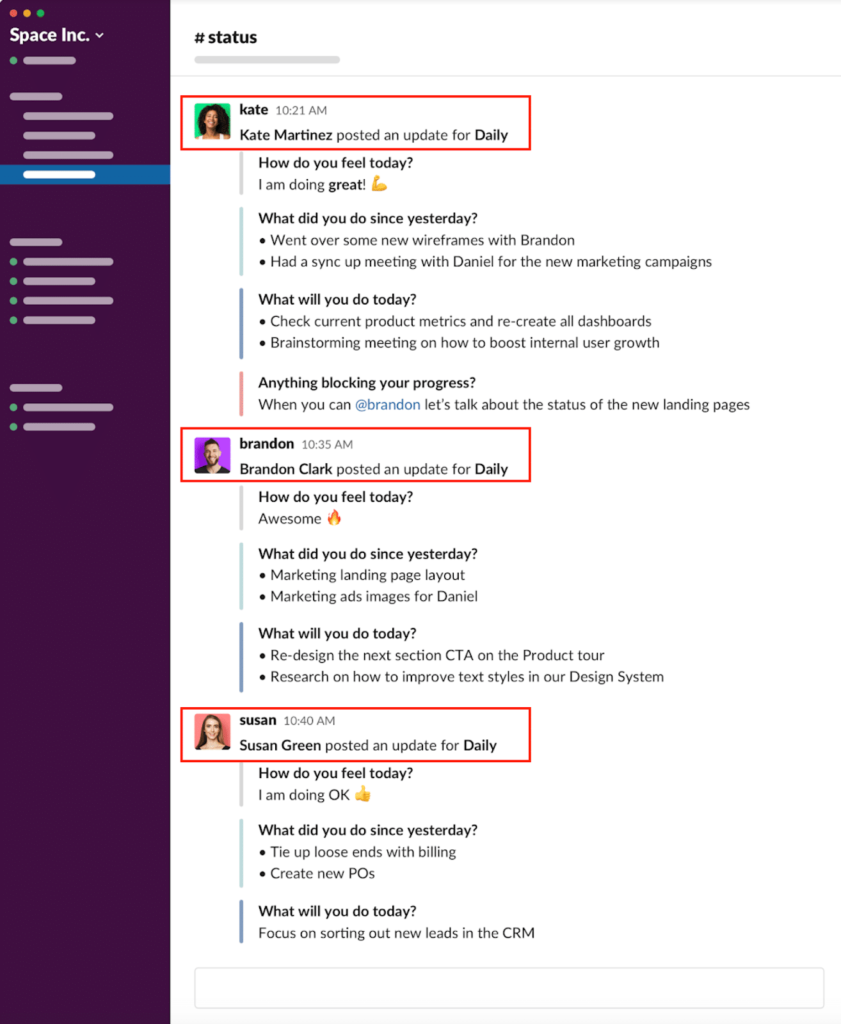
As you can see below, team members can then tag each other when they have a question or need assistance, and then start a conversation via thread (without disrupting and making everyone else sit through a conversation that isn’t pertinent to their week).

Easily Finding Valuable Insights
Geekbot also makes it easy to gain valuable data-driven insights from the weekly status update responses.
For example, you can use Geekbot’s report dashboard to get a quick at-a-glance view of several important metrics, such as how many of your teammates are participating in the weekly report process, report streaks, reminders for who is out of office, and more.

Plus, as you can see above, in the upper right corner of the dashboard you have a graph called “Team happiness.” Geekbot uses advanced language learning to decode your team’s updates responses in their reports, and give their feedback a positive, neutral, or negative rating.
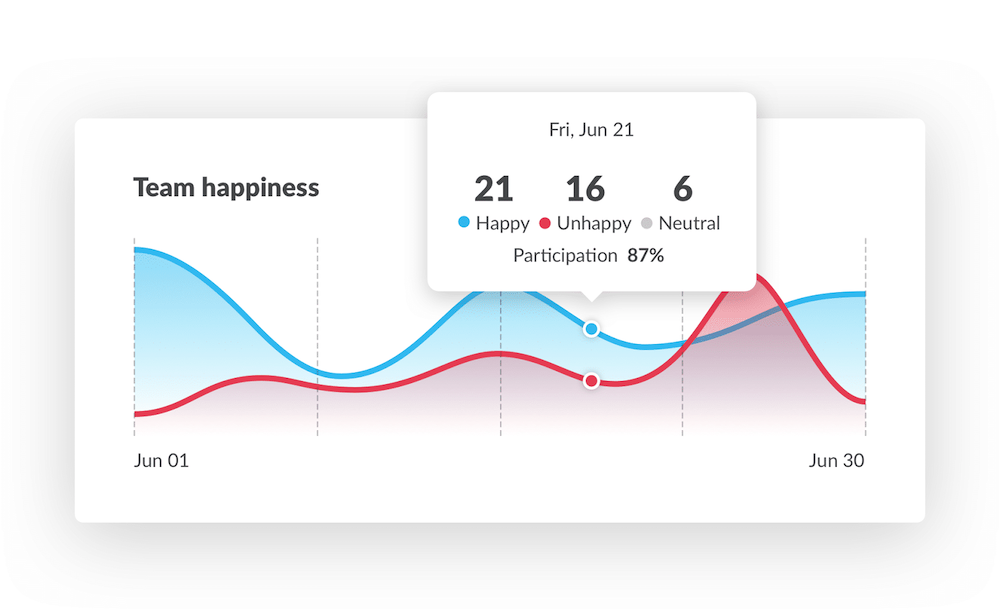
This helps you keep your finger on the pulse of your company culture (as we’ve written about in more depth in our GitLab case study on How to Increase Team Camaraderie Remotely).
You can also take advantage of our Conversational Analytics feature to find specific answers to your questions.
For example, as you can see below, if you ask Geekbot “What has the team done on onboarding in the last two months?”, Geekbot will send you the answer directly in Slack or MS Teams.
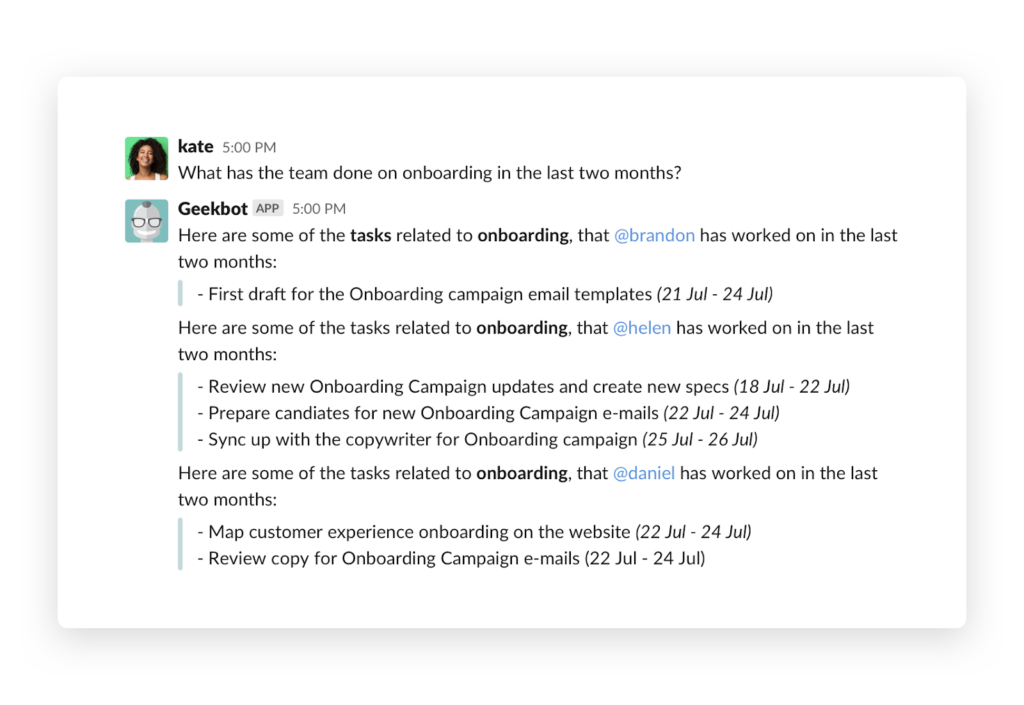
Note: For more examples of questions you can ask Geekbot via the Conversational Analytics feature, click here.
Final Thoughts: Why Use Geekbot to Run Asynchronous Weekly Updates
By using Geekbot to run asynchronous weekly status updates, you can:
- Easily schedule out reports in advance
- Factor in everyone’s schedule and timezone
- Make it easy for your team to fill out their responses
- Set reminders so your team doesn’t have to worry about forgetting to finish their update
- Centralize your team’s responses in the Geekbot dashboard and gain valuable data driven insights
Note: Click here to get started. Geekbot is free for teams of 10 or fewer. Plus, larger teams can try Geekbot free for 30 days.
Frequently asked questions
How do I run a status update meeting?
Set the agenda before you start the meeting. To do this, use your own status updates to generate a list of things people can talk about during the session. Created questions for each topic and group them by category, participants, or replies. Ask the questions during the discussion. Having the same outline for weekly status meetings gives participants clarity and promotes consistency.
How do you write a good weekly status report?
The best way to write an excellent weekly status report is to outline your goals beforehand. Ask yourself the following questions. Who will be reading this report? What do you want your management to learn from this report? What are the most crucial data points should your weekly status report? How will this report be used in the future?
What is a weekly status report?
In a nutshell, the weekly status report is a complete review of your working week. A weekly status report consists of three parts: a recap of what was achieved during the last week, notable achievements, current challenges, and plans for the next week. A weekly report is a great tool to keep teams accounted, review progress, and update non-present stakeholders.



